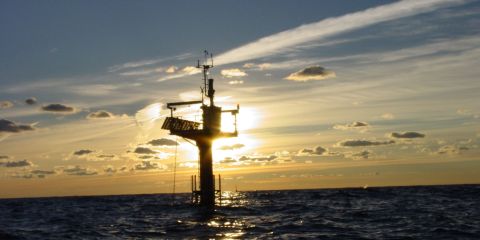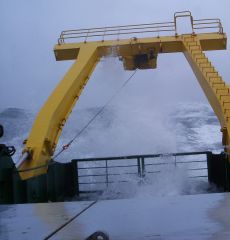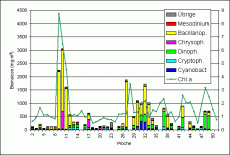

Phytoplankton development at the coastal station "Seebrücke Heiligendamm" in 2003
The results of the weekly sampling at the sea-bridge Heiligendamm (54°08,55' N; 11°50,60' E, 300 m off shore, 3 m water depth), performed by the Baltic Sea Research Institute Warnemünde (IOW) are shown in Fig. 1. The line reflects the chlorophyll a concentration and the columns the phytoplankton wet weight. Columns are lacking on particular sampling dates if quantitative microscopical counting was not possible due to high content of resuspended sediments in the samples owing to strong wind.
In the first weeks of 2003, phytoplankton biomass was low and dominated by cryptophyceae (mainly Teleaulax sp.). A slight development of diatoms (Skeletonema costatum, Thalassiosira anguste-lineata, T. levanderi) started already at the end of January. During a sunny period (9. week), diatoms grew abruptly, dominated by Skeletonema costatum (1662 mg m-3). The chlorophyll a peak of 8.8 mg m-3 was reached on 26.2.2003. This was a very early date of the spring bloom. At the peak of the biomass on 4.3.03, also the naked form of the chrysophyceae Dictyocha speculum occurred (648 mg m-3). The water temperature was still <1 °C. Only in the 12.week (18.3.03), when the bloom was over, it increased to 3 °C. After the spring bloom, cryptophyceae developed. Surprisingly, dinoflagellates grew very sparse.
The period of low biomass extended until the 23.6.03 (= 26. week), when the diatom Guinardia flaccida started growth. This species reached its peak (1398 mg m-3) already on 2.7.03 (= 27. week). Also Dactyliosolen fragilissimus (143 mg m-3) and Proboscia alata (129 mg m-3) were important. Until the 14.7.03 (= 29. week), only Dactyliosolen fragilissimus (238 mg m-3) remained as important diatom. One week later, Guinardia flaccida reappeared with 759 mg m-3. The dominance of Guinardia flaccida instead of the usual Dactyliosolen fragilissimus is noteworthy.
Nitrogen-fixing cyanobacteria (Nodularia spumigena, Aphanizomenon sp.) appeared on 29.7.03 (= 31. week) at our coastal station. This bloom stayed until 10.8.03 in front of Warnemünde and Heiligendamm. During this time, also Dactyliosolen fragilissimus and Prorocentrum minimum occurred in high biomass. The biomass decreased by the 26.8.03 (= 35. week) because of strong wind. On 9.9.03 (= 37. week), Ceratium tripos was found with a biomass of 437 mg m-3 but was replaced by Dactyliosolen fragilissimus (444 mg m-3) until 16.9.03. The quick changes in species composition seem to reflect quick drifting of different water masses within Mecklenburg Bight. A real succession occurred however until 23.9.03 (= 39. week) when Dactyliosolen fragilissimus was replaced by Coscinodiscus granii. In week 48 and 49, a stable bloom of Ceratium tripos and C. fusus established. It was accompanied by Cerataulina pelagica, Thalassiosira baltica, Th. anguste-lineata, Th. eccentrica, Teleaulax sp. and Mesodinium rubrum. The decrease in chlorophyll a concentrations indicate the disappearance of the bloom by the end of the year.
IOW, 10.03.2004
Dr. Norbert Wasmund,
Susanne Busch,
Ina-Marie Topp,
Regina Hansen.

State of the Baltic Sea
- Annual Reports on the state of the Baltic Sea Environment
- Cruise Reports
- Data from the autonomous measuring stations
- Development of the suboxic and anoxic regions since 1969
- Baltic Thalweg transect since 2014
- Algal blooms at Heiligendamm since 1998
- "Major Baltic Inflow" December 2014
- "Major Baltic Inflow" January 2003
- Baltic saline barotropic inflows 1887 - 2018
- Further Reading

